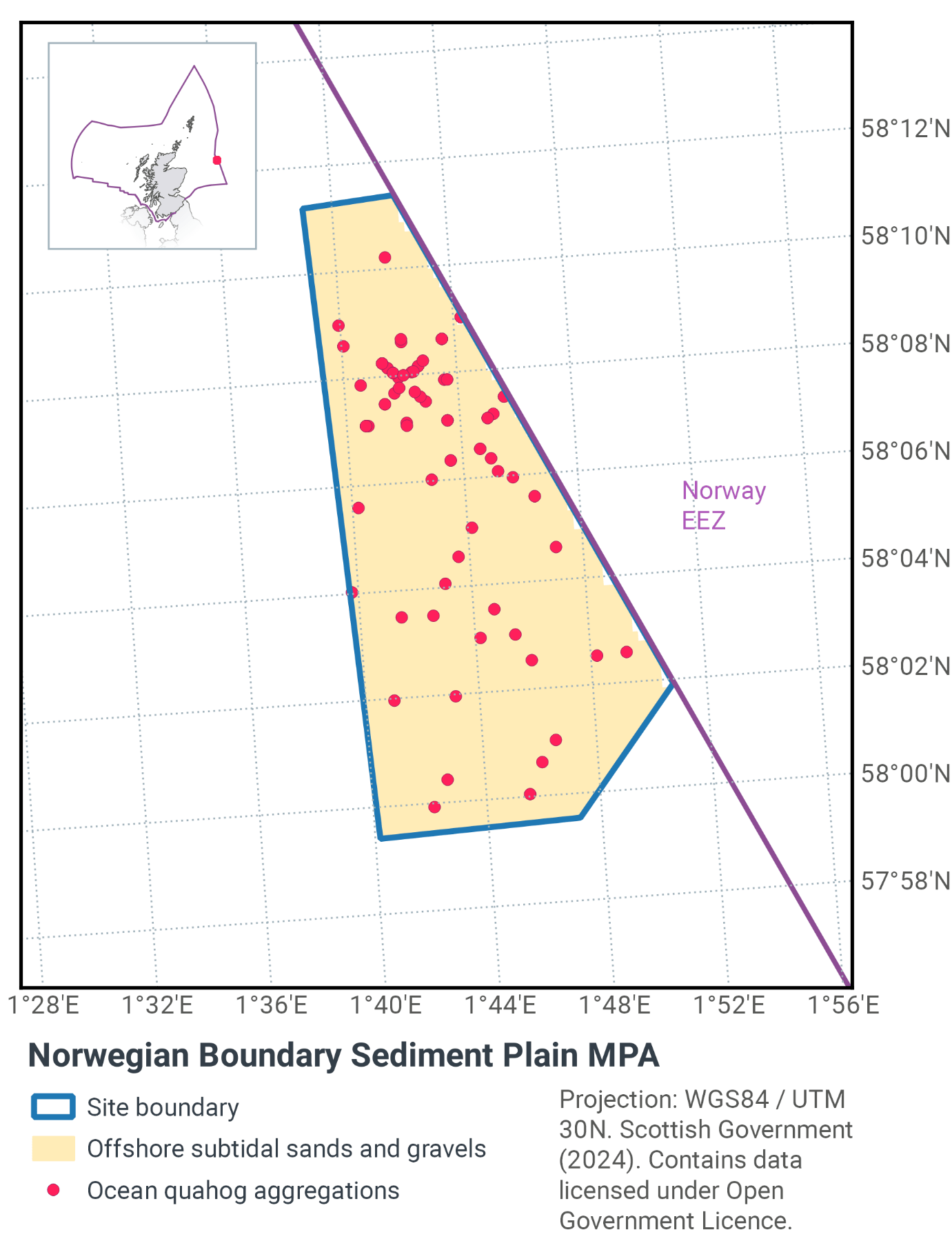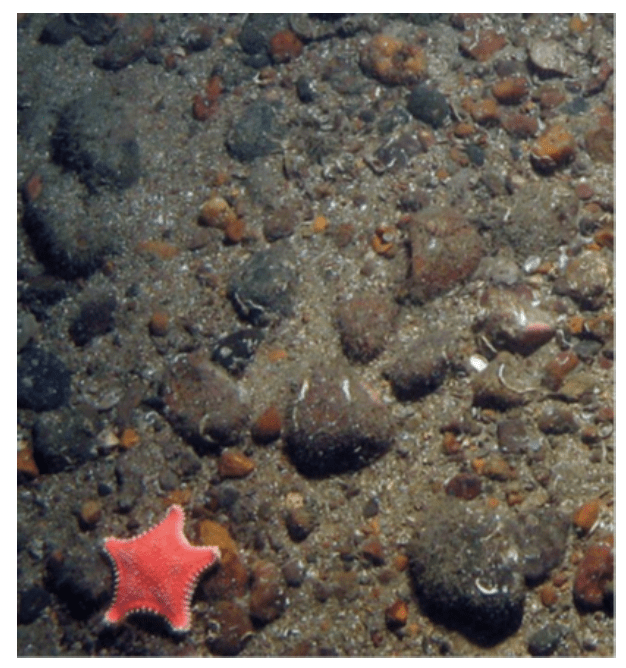Fisheries Management Measures within Scottish Offshore Marine Protected Areas (MPAs) - Site Proposal Document
This document describes the process, justification and evidence used to develop site specific management measures. It outlines key information for each site including their features, and risks of potential pressures.
13. Norwegian Boundary Sediment Plain MPA
13.1 Description and background
The Norwegian Boundary Sediment Plain MPA, as shown in Figure 28 and Figure 30, is home to a range of animals that live both in and on the sand and gravel habitats. This includes starfish, crabs, and the long-lived ocean quahog (Arctica islandica); see Figure 29 for example images. The MPA covers an area of 164 km2.
Ocean quahog are typically found in medium to fine grained sands, sandy mud and silty sand in water depths of 4 to 400 m. Survey data records from the MPA have confirmed the presence of ocean quahog within the depth range and sediment types in which they are expected to occur.
Further information can be found in the Site Information Centre.

13.2 Site Features
The Norwegian Boundary Sediment Plain MPA is designated for the following protected features:
- Ocean Quahog aggregations (including sands and gravels as their supporting habitat).
Ocean quahog aggregations are considered to be a priority for marine conservation in Scotland’s seas and considered appropriate for a spatial management approach.
The MPA makes a contribution to the OSPAR network for the protection of ocean quahog, considered to be Threatened and/or Declining in OSPAR Region II (Greater North Sea).
More information regarding the site selection process is available in the detailed assessment against the Scottish MPA selection guidelines.


Figure 29. Examples of the protected features within the Norwegian Boundary Sediment Plain MPA. a) sand and gravel habitats with cushion star (© JNCC and Cefas) and b) ocean quahog (Arctica islandica) (© Crown Copyright 2014, image provided by DEONI)
13.3 Site Boundary
The boundary has been set in accordance with the boundary setting principles outlined in the MPA Selection Guidelines. It includes both the survey records of ocean quahog and areas of sediments considered suitable for ocean quahog colonisation (Sabatini & Pizzolla, 2008).
Confidence in the presence and extent of the protected features has been set out in the Data Confidence Assessment.
13.4 Conservation objectives
JNCC’s view on the overall condition of the site’s qualifying feature is that it is in unfavourable condition and therefore needs to be restored to favourable condition.
The conservation objectives for the Norwegian Boundary Sediment Plain MPA are that the protected features:
- so far as already in favourable condition, remain in such condition; and
- so far as not already in favourable condition, be brought into such condition, and remain in such condition.
The full conservation advice documents can be found on the JNCC website. This includes the formal conservation advice for the site, background information and the full conservation objectives.
13.5 Pressure from demersal mobile fishing gear
Ocean quahog are caught or damaged by beam trawls (Klein & Witbaard 1993; Witbaard & Klein, 1994) with an individual pass of the gear causing around 20% mortality (Bergman & van Santbrink, 2000). This has been suggested as the cause of an observed decline in abundance over the last century in the south-eastern North Sea. A study in Dutch waters showed that quahog population density was inversely related to beam trawling effort (Craymeersch et al., 2000).
There is some evidence that otter trawl doors may impact ocean quahogs by bringing them to the surface (Rumohr & Krost, 1991), however there is insufficient evidence to assess the mortality caused by this gear at a population level. The northern North Sea is primarily fished by otter trawls and ocean quahog does not appear to have declined to the same extent as seen in southern areas.
No evidence was found on the effects of shellfish dredging. However, the physical effects of scallop dredging on seabed sediments are similar to those of beam trawls (penetration to depths >5 cm) and so the effects on ocean quahog are likely to be similar. Hydraulic gears penetrate sediments more deeply than other gears and so could be expected to cause a greater mortality, particularly where ocean quahog is the target species (although there is no known direct exploitation of the species in the UK).
As with demersal trawls and dredges, demersal seines may impact the structure and function of sedimentary habitats and the long-term survival of their associated species. There are currently no direct studies on the physical impacts of demersal seines. Modelling studies suggest that demersal seines have a large overall footprint (i.e. the surface area covered during one hour fishing) (Eigaard et al. 2016). Hiddink et al. (2017) suggest that depletion of biota is highly correlated with seabed penetration depth by trawls. Seines lack the heavy gear components (e.g. otter doors, trawl shoes) of other demersal mobile gears (Suuronen et al. 2012; Donaldson et al. 2010) and therefore, despite the relatively large footprint, impacts associated with penetration into the sediment are likely to be lower. Eigaard et al. (2016) modelled surface (<2cm) and subsurface (>2cm) impacts and found that demersal seines have some of the smallest proportions of subsurface impact.
13.6 Pressure from demersal static gear
Although the individual impact of a single static fishing operation may be slight, cumulative damage may be significant (Eno et al., 2001; Foden et al., 2010), however sensitivity to low intensity potting is considered low (Hall et al., 2008). Overall, ocean quahog aggregations are not considered to be sensitive to static gear activity (Hall et al., 2008), and the activity is not currently taking place within the MPA.
13.7 Levels of fisheries management considered
Table 18 provides a summary of the management advice set out against the various options that have been considered.
(Table 18) Summary of fisheries management advice for Norwegian Boundary Sediment Plain MPA
Fisheries management options considered for demersal mobile gear
No additional management: There is a risk of not achieving the conservation objective for ocean quahog aggregations.
Reduce / limit pressures: This level of management would reduce, but not entirely eliminate, the risk of not achieving the conservation objective for ocean quahog aggregations. Appropriate management could include restrictions on gears known to impact the species, such as scallop and hydraulic dredging. Restrictions could be permanent in some cases or temporary/adaptive in others.
Remove / avoid pressures: This level of management would reduce the risk of not achieving the conservation objective for ocean quahog aggregations to the lowest possible levels. This level of management could include restrictions on gears that could impact the species, such as otter trawling as well as scallop and hydraulic dredging.
Fisheries management options considered for demersal static gear
No additional management: It is unlikely that any additional management of static gear activities will be required, as the risk of not achieving the conservation objectives of ocean quahog aggregations associated with these activities is minimal. Currently, no static gear activity is taking place within the MPA; however, if it were to start and monitoring showed evidence of detrimental effects, it may be necessary to apply limits in the future.
13.8 Proposed fisheries management and rationale
Table 19 and Figure 30 provide details of the proposed management approach and further explanation is provided below. Figure 31 shows the proposed fisheries management for full site prohibitions.
Protected feature: |
Gear type |
Proposed management |
Measures |
|---|---|---|---|
Ocean quahog aggregations (including sands and gravels as their supporting habitat) |
Demersal mobile |
Reduce / limit pressure |
Prohibit the use of dredges, beam trawls, other demersal trawls, and pair seines from the whole MPA. Zonal management of demersal seines. |
Demersal static |
No additional management |
No demersal static gear measures applied |
The Norwegian Boundary Sediment Plain MPA contains an area which is considered to be least damaged, more natural. It was agreed at the stakeholder workshop that this area in the northern part of the MPA should be given a high level of protection to maintain that status. This means that this area in effect provides a reference point for a more natural habitat condition in the North Sea. This may prove helpful for future assessments of environmental status.
In the southern part of the MPA there has been little or no activity in recent years, however a precautionary approach is being taken by prohibiting activity to ensure the ensuring condition of the MPA is maintained or improved.
Ocean quahog is listed as an OSPAR threatened and/or declining species in OSPAR region II. These measures would make a significant contribution towards recovery of the species. They should also further progress towards Good Environmental Status in the Greater North Sea, particularly in relation to Descriptors 1 (biological diversity) and 6 (sea-floor integrity).
In recognition of the lower impact of seine net fishing (except for pair seines which are more similar to pair trawls in use and effect), this gear) will still be permitted in the southern part of the MPA.


Contact
Email: marine_biodiversity@gov.scot
There is a problem
Thanks for your feedback